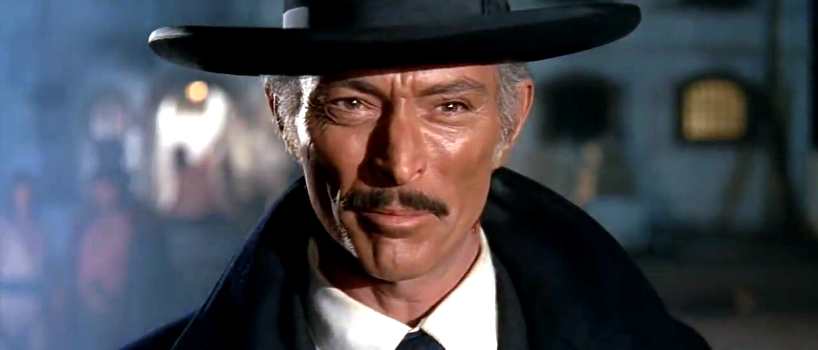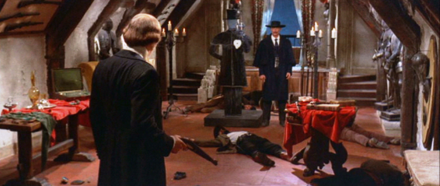Sabata Review (Scherpschutter): Difference between revisions
No edit summary |
No edit summary |
||
| (44 intermediate revisions by 4 users not shown) | |||
| Line 1: | Line 1: | ||
---- | |||
<center> [[File:Ehi-amico-ce-sabata-hai-chiuso.jpg]] </center> | |||
In 1969 the production of spaghetti westerns was in decline, but [[Gianfranco Parolini]]'s tongue-in-cheek If you meet Sartana, Pray for your Death (1968) had done reasonably well. A sequel was inevitable, but because Parolini had fallen out with his producer Aldo Addobbati, it was directed by [[Giuliano Carnimeo]]. Parolini then got the offer, from Alberto Grimaldi (from Leone's production house Pea), to direct a similar tongue-in-cheek movie, featuring a character named Sabata. Lee Van Cleef had no experience with the more light-hearted approach to the genre and was therefore rather sceptic, but he was taken to a showing of Parolini's war adventure movie ''Five for Hell'', a kind of light version of ''The Dirty Dozen''. Lee didn’t understand a word of it, but the cinema had been full of young Italians who apparently had the time of their life. He thought it was time for a career move ... | |||
Sabata accidently witnesses a bank robbery in which a load of army money is stolen. He kills the robbers and takes the money back into town, only to discover that the robbery was masterminded by three respected citizens, the judge, the banker and a rancher called Stengel, a homosexual sadist who has a private room in which he executes people. Sabata threatens to inform the army and starts blackmailing the three dignitaries. Two of them are willing to pay, but Stengel convinces them to hire professional killers to eliminate Sabata. They all fail, but then Stengel asks Sabata's former friend Banjo if he's interested ... | |||
[[ | ---- | ||
<center> [[File:Sabata_full_movie_1969_720p.mp4_005716421.png]] </center> | |||
---- | |||
Parolini wasn't the only person who made the switch from Sartana to Sabata. [[William Berger]] had been in the first Sartana movie too, and so had Rizzo (the fat judge). Sabata would become one of the most colorful heroes within the genre: Like Sartana, he has a preference for miniature guns and a staggering ability to pop up in the wrong place at the right time. Like Colonel Mortimer, he uses a rifle with an extendable barrel for long-range shooting. He is the proverbial new man in town who changes everything, and by challenging the local authorities he also attracts the attention of those who live in the margin. Significantly two outcasts obtrude themselves upon him, a foul-mouthed town drunk called Garrincha (or Carrincha), and a mute acrobat by the name of Alley Cat. | |||
Spaghetti westerns had always had an ambiguous relationship with realism, but in Sabata the thinnest of lines is cut when Van Cleef throws a coin in a nickelodeon from across the room. A similar coin trick is used during the film’s finale, but this time to eliminate the main villain. Instead of the tense atmosphere and ritual gun duels à la Leone, we get a gimmick-ridden variety of trick weapons, acrobatic stunts and pyrotechnics. But the body count is still quite high and the action pretty tough. Lee is a privilege to watch (as always) and excellent support is given by Franco Ressel, as Stengel, and Berger - in what is most probably is best spaghetti western part - as Banjo, the red-haired womanizer with a rifle hidden in the instrument that gave him his name. Linda Veras adds a touch of sexy class to the movie as Banjo’s love interest. | |||
---- | |||
<center> [[File:Vlcsnap-2016-02-22-17h21m52s496.png|440px]] [[File:Vlcsnap-2016-02-23-10h50m50s360.png|440px]] </center> | |||
---- | |||
The film has a typical labyrinth plot, with endless twists and double-crosses, in which no-one can be trusted. Not even when he's dead. [[:Category:Carlo Simi|Carlo Simi]]'s great production design does a lot for the movie; the western town of the Elios Studios never looked more colorful and lively and Stengel's torture room is a fascinating creation (see: screenshot 3). Giombini's score is excellent, although the main theme is used a few times too many. | |||
Carlo Simi's | |||
[[Category:Reviews]] | [[Category:Reviews]] | ||
| Line 53: | Line 26: | ||
[[Category:Linda Veras]] | [[Category:Linda Veras]] | ||
[[Category:Carlo Simi]] | [[Category:Carlo Simi]] | ||
<div style="border:1px solid #AAAAAA; padding:2px; margin:0px; font-size: 90%; font-weight:bold; text-indent:0.5em;">'''Sabata''' (1969) | [[Adiós Sabata Review|Adios Sabata]] (1970) | [[Return of Sabata Review by Scherpschutter|Return of Sabata]] (1971) - [[Ehi amico... c'è Sabata, hai chiuso!|View Database Page]] </div> | |||
'''Director:''' Gianfranco Parolini - '''Cast:''' Lee Van Cleef, William Berger, Linda Veras, Franco Ressel, Pedro Sanchez (Ignazio Spalla), Nick Jordan (Aldo Canti), Gianni Rizzo, Antonio Gradoli, Robert Hundar (Claudio Undari), Spartaco Conversi, Janos Bartha, Romano Puppo, Marco Zuanelli - '''Music:''' Marcello Giombini</center> | |||
<center> '''BRIEF REVIEW''' </center> | |||
''One of the best of Parolini’s circus westerns, featuring Lee van Cleef as the titular hero, a gunslinger who owes as much to James Bond as to No Name. William Berger co-stars as Banjo, the ladies’ man with a lethal musical instrument. The two fight each other and a trio of corrupt dignitaries, the judge, the banker and a rancher called Stengel, a homosexual sadist who has a private room in which he executes people. | |||
'' | |||
--By '''[[User:Scherpschutter|Scherpschutter]]''' | --By '''[[User:Scherpschutter|Scherpschutter]]''' | ||
Latest revision as of 16:27, 27 April 2018

In 1969 the production of spaghetti westerns was in decline, but Gianfranco Parolini's tongue-in-cheek If you meet Sartana, Pray for your Death (1968) had done reasonably well. A sequel was inevitable, but because Parolini had fallen out with his producer Aldo Addobbati, it was directed by Giuliano Carnimeo. Parolini then got the offer, from Alberto Grimaldi (from Leone's production house Pea), to direct a similar tongue-in-cheek movie, featuring a character named Sabata. Lee Van Cleef had no experience with the more light-hearted approach to the genre and was therefore rather sceptic, but he was taken to a showing of Parolini's war adventure movie Five for Hell, a kind of light version of The Dirty Dozen. Lee didn’t understand a word of it, but the cinema had been full of young Italians who apparently had the time of their life. He thought it was time for a career move ...
Sabata accidently witnesses a bank robbery in which a load of army money is stolen. He kills the robbers and takes the money back into town, only to discover that the robbery was masterminded by three respected citizens, the judge, the banker and a rancher called Stengel, a homosexual sadist who has a private room in which he executes people. Sabata threatens to inform the army and starts blackmailing the three dignitaries. Two of them are willing to pay, but Stengel convinces them to hire professional killers to eliminate Sabata. They all fail, but then Stengel asks Sabata's former friend Banjo if he's interested ...

Parolini wasn't the only person who made the switch from Sartana to Sabata. William Berger had been in the first Sartana movie too, and so had Rizzo (the fat judge). Sabata would become one of the most colorful heroes within the genre: Like Sartana, he has a preference for miniature guns and a staggering ability to pop up in the wrong place at the right time. Like Colonel Mortimer, he uses a rifle with an extendable barrel for long-range shooting. He is the proverbial new man in town who changes everything, and by challenging the local authorities he also attracts the attention of those who live in the margin. Significantly two outcasts obtrude themselves upon him, a foul-mouthed town drunk called Garrincha (or Carrincha), and a mute acrobat by the name of Alley Cat.
Spaghetti westerns had always had an ambiguous relationship with realism, but in Sabata the thinnest of lines is cut when Van Cleef throws a coin in a nickelodeon from across the room. A similar coin trick is used during the film’s finale, but this time to eliminate the main villain. Instead of the tense atmosphere and ritual gun duels à la Leone, we get a gimmick-ridden variety of trick weapons, acrobatic stunts and pyrotechnics. But the body count is still quite high and the action pretty tough. Lee is a privilege to watch (as always) and excellent support is given by Franco Ressel, as Stengel, and Berger - in what is most probably is best spaghetti western part - as Banjo, the red-haired womanizer with a rifle hidden in the instrument that gave him his name. Linda Veras adds a touch of sexy class to the movie as Banjo’s love interest.


The film has a typical labyrinth plot, with endless twists and double-crosses, in which no-one can be trusted. Not even when he's dead. Carlo Simi's great production design does a lot for the movie; the western town of the Elios Studios never looked more colorful and lively and Stengel's torture room is a fascinating creation (see: screenshot 3). Giombini's score is excellent, although the main theme is used a few times too many.
Director: Gianfranco Parolini - Cast: Lee Van Cleef, William Berger, Linda Veras, Franco Ressel, Pedro Sanchez (Ignazio Spalla), Nick Jordan (Aldo Canti), Gianni Rizzo, Antonio Gradoli, Robert Hundar (Claudio Undari), Spartaco Conversi, Janos Bartha, Romano Puppo, Marco Zuanelli - Music: Marcello Giombini
One of the best of Parolini’s circus westerns, featuring Lee van Cleef as the titular hero, a gunslinger who owes as much to James Bond as to No Name. William Berger co-stars as Banjo, the ladies’ man with a lethal musical instrument. The two fight each other and a trio of corrupt dignitaries, the judge, the banker and a rancher called Stengel, a homosexual sadist who has a private room in which he executes people.
--By Scherpschutter



